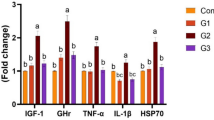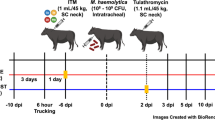Abstract
The objective of this study was to determine the changes in biochemical indicators for nutritional stress from a herd of Boran and Nguni cows. A total of 40 cows (20 from each herd) were randomly selected for the study. The animals were identified according to their parities as follows: parity 1 (n = 8), parity 2 (n = 16), parity 3 (n = 8) and parity 4 (n = 8). Serum chemistry levels of glucose, total cholesterol, urea, creatinine, albumin, globulin, aspartate aminotransferase (AST), alanine aminotransferase (ALT), alkaline phosphatase (ALP), gamma glutylaminotransferase (GGT), leukocytes, erythrocytes, haemoglobin, packed cell volume (PCV) and platelet counts were determined for 12 consecutive months spanning across the wet and dry seasons. The Boran cows had different creatinine concentration levels at different parities. The Boran cows in parity 1 had the highest (P < 0.05) concentration of creatinine 87.2 ± 5.17 μmol/L than other cows in different parities within the herd. There were significant differences in enzymes such as AST, ALP and ALT among the herd and parities. Boran cows in parity 3 had the lowest (P < 0.05) AST concentration levels of 52.6 ± 3.48 U/L, Nguni cows in parity 4 had the highest concentration of ALP of 161.3 ± 8.10 U/L while Nguni cows in parity 1 had the highest concentration level of ALT 55.1 ± 1.56 U/L than all the cows within the same herd. The Nguni herd had significantly higher (P < 0.05) levels of creatinine in both the wet (97.8 ± 3.27 μmol/L) and dry seasons (108.7 ± 3.29 μmol/L) compared with the Boran herd. Cows from the Nguni herd maintained significantly higher amount of urea, creatinine, albumin and total protein in both the wet and dry seasons as compared with cows from the Boran herd. Cows from the Nguni herd maintained significantly higher amount of urea, creatinine, albumin and total protein in both the wet and dry seasons as compared with those from the Boran herd.







Similar content being viewed by others
References
Abeni, F., Calamari, L., Stefanini, L., 2007. Metabolic conditions of lactating Fresian cows during the hot season in the Po valley. 1. Blood indicators of heat stress. International Journal of Biometeorology, 52, 87–96.
Acocks, J.P.H., 1988. Veld types of South Africa, third ed. Memoirs of Botanical Survey of South Africa. Government Printer, Pretoria, pp. 1–146.
A. O. A. C., 1994. Association of Official Analytical Chemists. Official Methods of Analysis. Washington, D.C.
Bergmeyer, H. U., Hoder, M., Rej, R., 1986. Approved recommendation on International Federation of Clinical Chemistry methods for the measurement of catalytic concentration of enzymes. Part II, International Federation of Clinical Chemistry method for aspartate amonio transferase. Journal of Clinical Chemistry and Clinical Biochemistry, 24, 497–510.
Berman, A., 2011. Invited review: are adaptations present to support dairy cattle productivity in warm climates? Journal of Dairy Science, 94, 2417–2158.
Calamari L, Petrera F., Abeni, F., Bertin, G. 2011. Metabolic and hematological profiles in heat stressed lactating dairy cows fed diets supplemented with different selenium sources and doses. Livestock Science, 142, 128–137.
Cozzi, G., Ravarotto, L., Gottardo, F., Stefani, A. L., Contiero, B., Moro, L., Brscic, M., Dalvit, P., 2010. Reference values for blood parameters in Holstein dairy cows: Effects of parity, stage of lactation, and season of production. Journal of Dairy Science, 94, 3895–3901.
DAGRIS. 2007. Domestic Animal Genetic Resources Information System (DAGRIS). (eds. J.E.O. Rege, O. Hanotte, Y. Mamo, B. Asrat and T. Dessie). International Livestock Research Institute, Addis Ababa, Ethiopia. http://dagris.ilri.cgiar.org. Accessed 30 November 2016.
Doumas, B. T., Biggs, H. G., 1972. Determination of serum albumin. In: Cooper, G. A. (Ed) Standard methods of clinical chemistry, vol 7, Academic Press, New York, USA.
FAO., 2014. Understanding the drought impact of El Nino on the global agricultural areas: an assessment using FAO’s agricultural stress index (ASI). Rome, Italy.
Faver, T. B., 1997. Concepts of normality in clinical biochemistry II. Reference interval determination and use. In: Kaneko, J., Harvey, J and Bruss, M. (eds) Clinical biochemistry of sometsic animals (5th ed). Academic Press, San Diego, USA.
Grunwaldt, E.G., Guevara, J.C., Este'vez, O.R., Vicente, A., Rousselle, H., Alcuten, N., Aguerregaray, D., Stasi C.R., 2005. Biochemical and haematological measurements in beef cattle in Mendoza Plain Rangelands (Argentina). Tropical Animal Health and Production, 37, 527–540.
Gwaze, R.F., Chimonyo, M., Dzama, K., 2010. Nutritionaly related blood metabolites and faecal egg counts in indigenous Nguni goats of South Africa. South African Journal of Animal Science, 40, 480–483.
Hansen, P.J., 2004. Physiological and cellular adaptations of Zebu cattle to thermal stress. Animal Reproduction Science, 82-83, 349–360.
Krishnegowda, A., Padmarajaiah, N., Anantharaman, S., Honnur K., 2013. Spectrophotometric assay of creatinine in human serum sample. Arabian Journal of Chemistry, doi: 10.1016/j.arabic.2013.07.030.
Lofgreen, G.P., Meyer, J.H., 1956. A method for determining total digestible nutrients in grazed forages. Journal of Dairy Science, 39, 268–273.
Mapfumo, L., Muchenje, V., 2015. Comparative changes in blood urea nitrogen, total protein concentrations, and body condition scores of Nguni cows and heifers raised on sweetveld. South African Journal of Animal Science, 45, 97–101.
Marufu M. C., Dzama K., Chimonyo M., 2013. Cellular responses to Rhipicephalus microplus infestations in pre-sensitised cattle with differing phenotypes of infestation. Experimental Applied Acarology, 62, 241–252.
Mertens, D. R., 2002. Gravimetric determination of amylse-treated neutral detergent fiber in feeds with refluxing in beakers or crucibles: collaborative study. Journal ofAOAC International, 85, 1217–1240.
Mucina, L., Rutherford, M. C., 2011. The vegetation of South Africa, Lesotho and Swaziland. SANBI, Pretoria, South Africa, pp. 513.
National Research Council., 1984. Nutrient requirements of beef cattle. 6th ed. National Academy of Sciences, National Academy Press, Washington, DC. USA.
Ndlovu, T., Chimonyo, M., Okoh, A.I., Muchenje, V., Dzama, K. Dube, S., Raats J.G., 2009. A comparison of nutritionally-related blood metabolites among Nguni, Bonsmara and Angus steers raised on sweetveld. The Veterinary Journal, 179, 273–281.
Osler, E. H., Lunington, M. J., Ford, Y., Swart, D., 1995. Grazing behaviour and forage utilisation of Nguni, Afrikaner and Simmentaler cattle. Ann Zootech, 44, 322, (Abstract).
Otto, F., Baggasse, P., Bogin, E., Harun, M., Vilela, F., 2000. Biochemical blood profile of Angoni cattle in Mozambique. Israel Journal of Veterinary Medicine, 55, 1–9.
Rewe, T. O., Indetie, D., Ojango, J. M. K., Kahi, A. K., 2006. Economic values for production and functional traits and assessment of their influence on genetic improvement in the Boran cattle in Kenya. Journal of Animal Breeding and Genetics, 123, 23–36.
S. A. S., 2010. Statistical Analysis System version 9.3. Cary, NC. USA.
Schoeman, S. J., 1989. Recent research into production potential of indigenous cattle with special reference to the Sanga. South African Journal Animal Science, 19, 55–61.
Scholtz, M. M., Linnington, M. J., 2006. Is the Nguni adapted to low quality pastures? Nguni Journal, p. 39.
Scholtz, M. M., Fursternberg, D., Maiwashe, A., Makgahlela, M. L., Theron, H. E., and van der Westhuizen, J., 2010. Environmental-genotype responses in livestock to global warming: a southern African perspective. South African Journal of Animal Science, 40, 408–413.
South African Yearbook (a)., 2013. South African Yearbook: water affairs, www.gov.za. Accessed 23 June 2014.
Tietjen, B., 2015. Same rainfall amount different vegetation-How environmental conditions and their interactions influence savanna dynamics. Ecological Modelling, 326. 13–22.
Tietz, N. W., 1995. Clinical guide to laboratory tests (3rd ed). W. B. Saunders Company. Philadelphia, USA.
van Oudtshoorn, F., 2012. Guide to grasses of southern Africa. (3rd ed). Birza Publications, Pretoria, South Africa. pp. 45–257.
Vetter, S., 2009. Drought, change and resillience in South Africa’s arid and semi-arid rangelands. South African Journal of Science, 105. 29–33.
Weicheslbaum, T. E., 1946. Interpretation of diagnostic tests (7th ed). Lippincott, Williams and Wilkins, Philadelphia, USA.
Wisloff, H., Flaoyen, A., Ottensen, N. Hove, T., 2003. Narthecium ossifragum (L.) Huds. Causes kidney damage in goats: morphologic and functional effects. Veterinary Pathology, 40, 317–327.
World Meteorological Organization, 2013. The global climate, 2001–2010: a decade of climate ext summary report. www.wmo.int. Accessed 5 August 2016.
World Meteorological Organization, 2016. Weather and climate water. www.wmo.int. Accessed 5 August 2016.
Yokus, B., Cakir, U. D., 2006. Seasonal and physiological variations in serum chemistry and mineral concentrations in cattle. Biological Trace Elements Research, 109, 255–266.
Acknowledgements
This research was sponsored partly by Adam Fleming through the Nguni Cattle project (Project P329) and the other part by National Research Foundation RTF projects (IUD numbers RTF150329116339 and RTF150522118247).
Author information
Authors and Affiliations
Corresponding author
Ethics declarations
Conflict of interest
The authors of this article declare no conflict of interest with any organisation or entity with any financial or non-financial support to the study. The grantholder also acknowledges that opinions, findings and conclusions or recommendations expressed in this publication are of the authors, and that the sponsors holds no liability whatsoever in this regard.
Rights and permissions
About this article
Cite this article
Mapfumo, L., Muchenje, V., Mupangwa, J.F. et al. Changes in biochemical proxy indicators for nutritional stress resilience from Boran and Nguni cows reared in dry arid rangeland. Trop Anim Health Prod 49, 1383–1392 (2017). https://doi.org/10.1007/s11250-017-1338-0
Received:
Accepted:
Published:
Issue Date:
DOI: https://doi.org/10.1007/s11250-017-1338-0




